Iguana
Iguana (/ɪˈɡwɑːnə/,[1][2] Spanish: [iˈɣwana]) is a genus of herbivorous lizards that are native to tropical areas of Mexico, Central America, South America, and the Caribbean. The genus was first described in 1768 by Austrian naturalist Josephus Nicolaus Laurenti in his book Specimen Medicum, Exhibens Synopsin Reptilium Emendatam cum Experimentis circa Venena. There were formerly considered to be only two species in the genus; the green iguana, which is widespread throughout its range and a popular pet, and the Lesser Antillean iguana, which is native to the Lesser Antilles; however, genetic analysis indicates that the green iguana may comprise a species complex of multiple species, some of which have been recently described.[3]
| Iguana | |
|---|---|
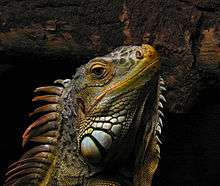 | |
| A green iguana (Iguana iguana) | |
| Scientific classification | |
| Kingdom: | Animalia |
| Phylum: | Chordata |
| Class: | Reptilia |
| Order: | Squamata |
| Suborder: | Iguania |
| Family: | Iguanidae |
| Genus: | Iguana Laurenti, 1768 |
| Species | |
| |
| Synonyms | |
| |

The word "iguana" is derived from the original Taino name for the species, iwana.[4] In addition to the two species in the genus Iguana, several other related genera in the same family have common names of the species including the word "iguana".
Anatomy and physiology
Iguanas can range from 1.5 to 1.8 metres (5 to 6 ft) in length, including their tail. The two species of lizard within the genus Iguana possess a dewlap and a row of elongated scales running from the midline of their necks down to their tails. Iguanas have varying types of scales covering different areas of their body, for example, there are some large round tuberculate scales scattered around the lateral region of the neck among smaller, overlapping scales.[5] The scales on the dorsal trunk of their body are also thicker and more tightly packed than those on the ventral side.[5] These scales may be a variety of colors and are not always visible from close distances. They have a large round scale on their cheeks known as a sub-tympanic shield.[6]
Iguanas have keen vision and can see shapes, shadows, colors, and movement at long distances. Their visual acuity enables them to navigate through crowded forests and to locate food. They employ visual signals to communicate with other members of the same species.[6]
The tympanum, the iguana's eardrum, is located above the sub-tympanic shield (or "ear shield") behind each eye. Iguanas are often hard to spot, as they tend to blend into their surroundings and their coloration enables them to hide from larger predators.[6]
Like most reptiles, an iguana has a three-chambered heart with two atria, one ventricle, and two aortae with a systemic circulation.[7] The muscles of an iguana are very light in color, this is due to the high proportion of fast glycolytic muscle fibers. These fibers are not very vascularized and are low in myoglobin, giving them their pale look. This high density of fast glycolytic muscle fibers allows iguanas to move very quickly for a short period of time, which facilitates short bursts of movement but is inefficient for long duration movement, since cellular respiration in fast glycolytic muscle fibers is anaerobic.
Parietal eye
Several species of lizard, including the iguana, have a pale scale towards the back of their head marking the parietal eye. This organ is sensitive to changes in illumination and sends signals to the pineal gland signaling the change between day and night. A photopigment commonly found in the lamprey, known as parapinopsin, is also found in the iguana and is photosensitive to UV light and aids in the signaling between day and night.[8]
Skull morphology and diet

Iguanas have developed an herbivorous lifestyle, foraging exclusively on vegetation and foliage.[9] In order to acquire, process and digest plant matter, herbivorous lizards must have a higher bite force relative to their size in comparison to carnivorous or omnivorous reptiles. The skull of the iguana has undergone modifications resulting in a strong bite force and efficient processing of vegetation, according to one study.[10]
In order to accomplish this biomechanically, herbivorous lizards (such as the iguana) have taller and wider skulls, shorter snouts, and larger bodies relative to carnivorous and omnivorous reptiles.[10] Increasing the robusticity of the skull allows for increased muscle presence and increases the ability of the skull to withstand stronger forces.[11]
_and_teeth.png)
Furthermore, the teeth of the iguana are acrodontal, meaning that their teeth sit on top of the surface of the jaw bone[12] and project upwards. The teeth themselves are small and serrated - designed to grasp and shear food.[13]
Reproduction
Male iguanas, like other male examples of Squamata, have two hemipenes. During copulation one hemipene will be inserted into the female's cloacal vent.[14] Females can store sperm from previous mates for several years to continue to fertilize her eggs in case she finds no male within her territory when she is ready to lay again.
Mating/courtship
Iguanas tend to follow a promiscuous or polygynadrous mating style during the dry season. Mating during the dry season ensures that their offspring will hatch during the wet or rainy season when food will be more plentiful. Females control large territories where they make several nests. Males compete amongst each other for the females in an area and mark their won territory with a pheromone secreted from the femoral pores on the dorsal side of their hind limbs. Male behavior during sexual competition involves head bobbing, extending and retracting their dewlap, nuzzling and biting the necks of females, and on occasion, changing color. Once a female chooses a male, he will straddle the female and hold her in place by biting onto her shoulder, which sometimes leaves scars on females. After copulation, eggs are laid within several nests and allowed to incubate. This low level of parental intervention with their offspring makes iguanas an example of r-strategy reproduction.
Phylogeny
A phylogeny based on nuclear protein-coding genes, reviewed by Vidal and Hedges (2009) suggested that the subclade Iguania is in a group with snakes and anguimorphs (lizards). These groups share an oral gland capable of secreting toxins (a derived trait).[15] On the other hand, the phylogeny based on whole mitochondrial genomes, proposed by Rest et al. (2003), places the green iguana as the closest relative of the mole skink (Plestiodon egregius).[16] Lepidosaurs are reptiles with overlapping scales, and within this group both iguanians and tuataras (Sphenodons) project their tongue to seize prey items instead of using their jaw, which is called tongue prehension. However, iguanians are the only lineage within Squamata that displays this trait, meaning that it was gained independently in both iguanians and tuataras.[15] Iguanians are also the only squamates that primarily use their sight to identify and track prey rather than chemoreception or scent, and employ an ambush technique of catching prey instead of active searching.[15]
A study by Breuil et al. (2020) found the taxonomy of the genus Iguana as follows, with I. delicatissima being the most basal member of the group.[3]
| |||||||||||||||||||||||||||||||
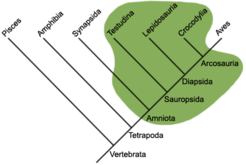
Extant species
| Image | Scientific name | Common Name | Distribution |
|---|---|---|---|
| Iguana delicatissima | Lesser Antillean iguana | The Lesser Antilles on Saint Barth, Anguilla, Sint Eustatius, Guadeloupe, Dominica, and Martinique | |
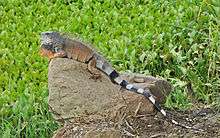 | Iguana iguana | Green iguana | Most of South America, from Colombia east to French Guiana and south to northern Argentina. Also introduced to parts of the Caribbean. If other species formerly considered conspecific are included, ranges north to southern Mexico and the southern Caribbean; specifically Grenada, Aruba, Curaçao, Trinidad and Tobago, St. Lucia, St. Vincent, and Útila. |
| Iguana insularis[3][17] | Southern Antillean horned iguana | St. Lucia, St. Vincent and the Grenadines, Grenada, considered conspecific with I. iguana until recently | |
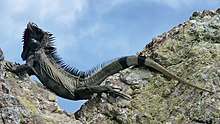 |
Iguana melanoderma[3] | Saban black iguana | Saba, Montserrat, and formerly Redonda, but also possibly coastal Venezuela, the Virgin Islands, and Puerto Rico (at least parts of this range may derive from (pre)historic introductions). |
| Iguana rhinolopha[17][18] | Central American iguana | Southern Mexico to northern Panama, generally considered conspecific with I. iguana until recently. Introduced to parts of the Caribbean as well as Florida. | |
The Central American iguana (I. rhinolopha or I. iguana rhinolopha) was formerly considered synonymous with I. iguana as the presence of horns does not necessarily indicate a new species or subspecies. The two described subspecies of I. insularis (the Saint Lucia horned iguana (I. i. sanctaluciae) and the Grenadines horned iguana (I. i. insularis)) were originally described as subspecies of I. iguana, although they are genetically very similar and may not be separate subspecies from one another.[19] However, recent studies have recovered I. rhinolopha and I. insularis as distinct species based on genetics.[18] The Curaçao population of green iguana shows major genetic divergence and may also represent an as-of-yet undescribed species.[3][20]
As food
Iguanas have historically featured in the culinary traditions of Mexico and Central America. Iguana meat is also consumed in parts of the United States and Puerto Rico.[21] Also, the eggs of iguana are consumed in some parts of Latin America, such as Nicaragua and Colombia.[22]
Images

 Green iguana on St. Thomas
Green iguana on St. Thomas Another green iguana
Another green iguana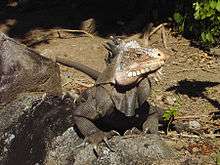 A Lesser Antillean iguana in the wild in Dominica
A Lesser Antillean iguana in the wild in Dominica An invasive green iguana on Grand Cayman
An invasive green iguana on Grand Cayman A green iguana at an environmental reserve at La Manzanilla, Jalisco, Mexico
A green iguana at an environmental reserve at La Manzanilla, Jalisco, Mexico A green iguana at Butterfly World, Stellenbosch, South Africa
A green iguana at Butterfly World, Stellenbosch, South Africa- A green iguana at Bannergatta, Bangalore, India
 A green iguana in Indira Gandhi Zoological Park, Visakhapatnam, India
A green iguana in Indira Gandhi Zoological Park, Visakhapatnam, India

 A green iguana Al Ain Zoo, U.A.E.
A green iguana Al Ain Zoo, U.A.E.
References
- Cambridge Dictionary
- Oxford Dictionaries
- Breuil, M.; Schikorski, D.; Vuillaume, B.; Krauss, U.; Morton, M.N.; Corry, E.; Bech, N.; Jelić, M.; Grandjean, F. (2020). "Painted black: Iguana melanoderma (Reptilia, Squamata, Iguanidae) a new melanistic endemic species from Saba and Montserrat islands (Lesser Antilles)". ZooKeys. 926: 95–131. doi:10.3897/zookeys.926.48679.
- Coles, William (2002), "Green Iguana" (PDF), U.S.V.I. Animal Fact Sheet #08, Department of Planning and Natural Resources US Virgin Islands Division of Fish and Wildlife, archived from the original (PDF) on 2007-12-11
- Chang, Cheng; Wu, Ping; Baker, Ruth E.; Maini, Philip K.; Alibardi, Lorenzo; Chuong, Cheng-Ming (2009). "Reptile scale paradigm: Evo-Devo, pattern formation and regeneration". The International Journal of Developmental Biology. 53 (5–6): 813–826. doi:10.1387/ijdb.072556cc. ISSN 0214-6282. PMC 2874329. PMID 19557687.
- Lazell, J.D. (1973), "The lizard genus Iguana in the Lesser Antilles", Bulletin of the Museum of Comparative Zoology, New York, 145, pp. 1–28
- DABVP, Ryan S. De Voe DVM MSpVM DACZM. "Reptilian cardiovascular anatomy and physiology: evaluation and monitoring (Proceedings)". dvm360.com. Retrieved 2017-05-13.
- Wada, Seiji (June 2012). "Expression of UV-Sensitive Parapinopsin in the Iguana Parietal Eyes and Its Implication in UV-Sensitivity in Vertebrate Pineal-Related Organs". PLOS ONE. 7 (6): 6. Bibcode:2012PLoSO...739003W. doi:10.1371/journal.pone.0039003. PMC 3375259. PMID 22720013.
- Lichtenbelt, Wouter D. van Marken (1993-08-01). "Optimal foraging of a herbivorous lizard, the green iguana in a seasonal environment". Oecologia. 95 (2): 246–256. Bibcode:1993Oecol..95..246V. doi:10.1007/BF00323497. ISSN 0029-8549. PMID 28312949.
- Metzger, Keith A.; Herrel, Anthony (2005-12-01). "Correlations between lizard cranial shape and diet: a quantitative, phylogenetically informed analysis". Biological Journal of the Linnean Society. 86 (4): 433–466. doi:10.1111/j.1095-8312.2005.00546.x. ISSN 0024-4066.
- Herrel, Anthony (2009). "Jaw and hyolingual muscle activity patterns and bite forces in the herbivorous lizard Uromastyx acanthinurus". Archives of Oral Biology. 54 (8): 772–782. doi:10.1016/j.archoralbio.2009.05.002. PMID 19481732.
- "THE TEETH OF VERTEBRATE ANIMALS". inside.ucumberlands.edu. University of the Cumberlands. April 28, 2017. Retrieved April 28, 2017.
- Banzato, Tommaso; Selleri, Paolo; Veladiano, Irene A.; Martin, Andrea; Zanetti, Emanuele; Zotti, Alessandro (2012-01-01). "Comparative evaluation of the cadaveric, radiographic and computed tomographic anatomy of the heads of green iguana (Iguana iguana), common tegu ( Tupinambis merianae) and bearded dragon ( Pogona vitticeps)". BMC Veterinary Research. 8: 53. doi:10.1186/1746-6148-8-53. ISSN 1746-6148. PMC 3439268. PMID 22578088.
- Lenny Flank (2007). Iguanas: Their Biology and Captive Care. Red and Black Publishers. ISBN 978-0-9791813-2-0.
- Vidal, Nicolas; Hedges, S. Blair (2009). "The molecular evolutionary tree of lizards, snakes, and amphisbaenians". Comptes Rendus Biologies. 332 (2–3): 129–139. doi:10.1016/j.crvi.2008.07.010. PMID 19281946.
- Rest, Joshua S.; Ast, Jennifer C.; Austin, Christopher C.; Waddell, Peter J.; Tibbetts, Elizabeth A.; Hay, Jennifer M.; Mindell, David P. (2003). "Molecular systematics of primary reptilian lineages and the tuatara mitochondrial genome". Molecular Phylogenetics and Evolution. 29 (2): 289–297. doi:10.1016/S1055-7903(03)00108-8. PMID 13678684.
- Breuil, Michel; Vuillaume, Barbara; Schikorski, David; Krauss, Ulrike; Morton, Matthew N.; Haynes, Pius; Daltry, Jennifer C.; Corry, Elizabeth; Gaymes, Glenroy; Gaymes, Joanne; Bech, Nicolas (2019-05-20). "A story of nasal horns: two new subspecies of Iguana Laurenti, 1768 (Squamata, Iguanidae) in Saint Lucia, St Vincent & the Grenadines, and Grenada (southern Lesser Antilles)". Zootaxa. 4608 (2): 201–232. doi:10.11646/zootaxa.4608.2.1. ISSN 1175-5334.
- Stephen, Catherine L.; Reynoso, Víctor H.; Collett, William S.; Hasbun, Carlos R.; Breinholt, Jesse W. (2013). "Geographical structure and cryptic lineages within common green iguanas, Iguana iguana". Journal of Biogeography. 40 (1): 50–62. doi:10.1111/j.1365-2699.2012.02780.x. ISSN 1365-2699.
- "Iguana iguana". The Reptile Database. Retrieved 2020-04-15.
- Breuil, Michel; Vuillaume, Barbara; Schikorski, David; Krauss, Ulrike; Morton, Matthew N.; Haynes, Pius; Daltry, Jennifer C.; Corry, Elisabeth; Gaymes, Glenroy; Gaymes, Joanne; Bech, Nicolas (2018-11-08). "A story of nasal horns: A new species of Iguana Laurenti, 1768 (Squamata, Iguanidae) in Saint Lucia, St Vincent & the Grenadines, and Grenada (Southern Lesser Antilles) and its implications for the taxonomy of the genus Iguana". bioRxiv: 466128. doi:10.1101/466128.
- Campo-Flores, Arian (2012-08-20). "To Battle Iguanas, Puerto Rico Has New Plan: Put Them on Menu". Wall Street Journal. ISSN 0099-9660. Retrieved 2020-01-23.
- "Nicaragua's Government Suggests Eating Iguana as Massive Food Crisis Looms". Vice. Retrieved 21 February 2020.
Further reading
| Wikimedia Commons has media related to Iguana. |
- Frost, D. R. (1989). "A phylogenetic analysis and taxonomy of iguanian lizards". Pub Univ Kansas. 81: 1–65.
- Frost, D. R.; Etheridge, R.; Janies, D.; Titus, T. A. (2001). "Total evidence, sequence alignment, evolution of polychrotid lizards, and a reclassification of the Iguania (Squamata: Iguania)". American Museum Novitates. 3343: 1–39. doi:10.1206/0003-0082(2001)343<0001:TESAEO>2.0.CO;2. hdl:2246/2896.